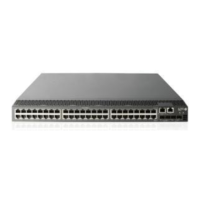72
FTP server configuration example
Network requirements
Create a local user account with username abc and password abc and enable FTP server on the IRF
fabric in Figure 28. U
se the user account to log in to the FTP server from the FTP client, upload the file
newest.bin from the FTP client to the FTP server, and download the configuration file config.cfg from the
FTP server to the FTP client for backup.
Figure 28 Network diagram
Configuration procedure
1. Configure the FTP server:
# Examine the storage medium of the device for insufficiency or impairment. If no sufficient free
space is available, use the delete/unreserved file-url command to delete unused files. (Details not
shown.)
# Create a local user account abc, set its password to abc and the user privilege level to level 3 (the
manage level), specify the Flash root directory of the master device as the authorized directory,
and specify the service type as FTP.
<Sysname> system-view
[Sysname] local-user abc
[Sysname-luser-abc] password simple abc
[Sysname-luser-abc] authorization-attribute level 3
[Sysname-luser-abc] authorization-attribute work-directory flash:/
[Sysname-luser-abc] service-type ftp
[Sysname-luser-abc] quit
To access the Flash root directory of the subordinate device (with the member ID 2), replace flash:/
in the command authorization-attribute work-directory flash:/ with slot2#flash:/.
# Enable the FTP server.
[Sysname] ftp server enable
[Sysname] quit
2. Perform FTP operations from the FTP client:
# Log in to the FTP server at 1.1.1.1 using the username abc and password abc.
c:\> ftp 1.1.1.1
Connected to 1.1.1.1.
220 FTP service ready.
User(1.1.1.1:(none)):abc
331 Password required for abc.

